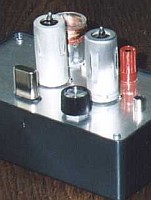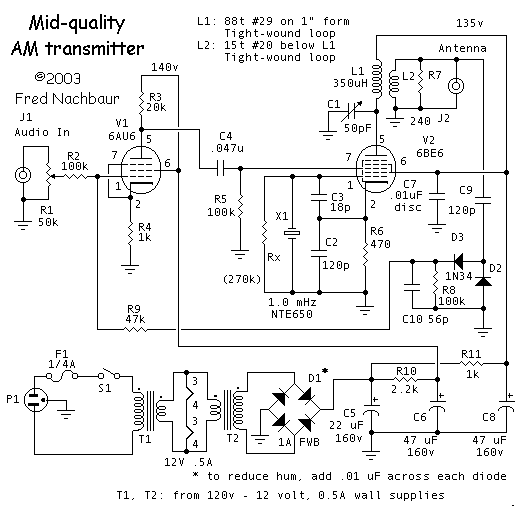
|
|
"The Bean Counter" (2 tubes) |
|
The "Muntz" one-tube design can be considerably improved by
adding an audio preamplifier stage. This will give improved sensitivity, and
thus give full modulation with lower-level signal sources (such as some older CD
players, ceramic phono cartridge, etc.). Furthermore, the use of negative
feedback around the whole transmitter improves linearity and allows for deeper
modulation levels without distortion.
|

|
While the one-tube transmitter works well for such a simple circuit, it does have significant drawbacks. One problem is that the input sensitivity is a too low for some common input sources. Another is that linearity could be improved; the one-tube basic transmitter has a somewhat strident audio quality at higher modulations because of harmonics introduced by the non-linearity. Adding a second tube (as an audio preamp) solves the first problem, and improves the second. |
| This is essentially "The Muntz" with a preamp stage, consisting of a 6AU6 pentode. This gives lots of gain, in fact enough for even high-output microphones. However, since this circuit is most useful to us as a line-level amplifier (in the range of 0.1 to 2 volts RMS), we can readily afford to trade some of this gain for fidelity by adding an overall negative feedback loop. The network around the pair of germanium diodes full-wave rectifies the modulated RF output, just like the detector in a radio receiver. This recovered audio is fed back, out of phase, to the input of the preamp. While germanium diodes are less linear than vacuum diodes, this is mollified by the fact that they're inside the feedback loop. |

|
|
We haven't changed anything in the RF section, so the output power of this
version is still only 3 milliwatts, but plenty for in-house broadcasting
(or if your linear has enough gain). What's more, the circuit was tweaked to
help reduce harmonic output. The tank inductor in the tuned circuit was wound
in a loop topology instead of solenoid, yielding a much higher inductance for a
given wire length, and hence a higher Q to help reduce harmonics. Tuning proceeds
just like "The Muntz", except that you'll find it much easier to
discern the clipping point due to the negative feedback loop on the audio.
The feedback method is a bit unconventional, and relies on the input source to be of relatively low impedance. However, it works very well, linearizing the modulated signal nicely. The improvement in sound is quite noticeable, especially when listening on good vintage AM receivers. The cathode of the 6AU6 is unbypassed, giving some local negative feedback. Though you might be tempted to bypass it, this isn't recommended since it can result in instability of the overall feedback loop. Note that this overall feedback system doesn't have an isolating cap to the input (grid) of the 6AU6. This is so that the DC component is also fed back, along with the audio component. This helps to overcome the load dependance of the un-isolated oscillator. If the average RF level decreases due to changing load conditions, the DC voltage feedback decreases also (goes more negative), decreasing the transconductance (and therefore voltage gain) of the 6AU6, and effectively reducing the modulation to compensate. (You might think that a remote-cutoff pentode such as 6BA6 would be preferred, but in practise the variance in DC voltage is not enough to have a significant effect using the 6BA6, etc.) The RF choke in the cathode of the oscillator has also been eliminated. The crystal oscillator is a bit more finicky using a resistor instead of a choke, but with the values shown it's stable and reliably self-starting. This approach also slightly reduces the maximum modulation depth from 90% to about 85%, which is still quite acceptable for in-house use. Here's a pic of the "Bean Counter." Since I was counting beans to build this one, I finally used up a rather ugly Radio Shack project box that's been kicking around here for eons. Since with this box the "Radio Scrap Retro Hobby Kitsch" (RS-RHK™) look is unavoidable, I took the theme to the max, complete with ugly red binding post, tank coil wound on an old spray-bottle cap, and oddly-placed sockets and components. |
 |
 |
 |
BACK | INDEX | NEXT |